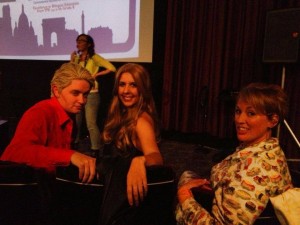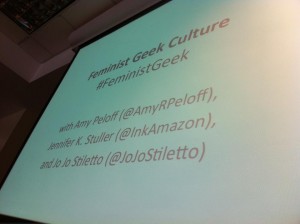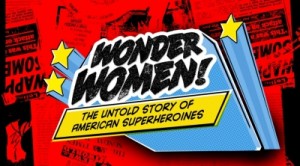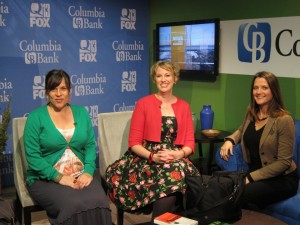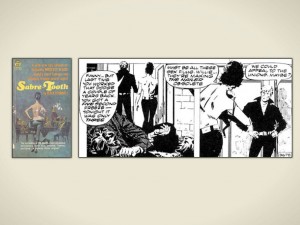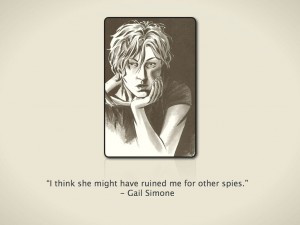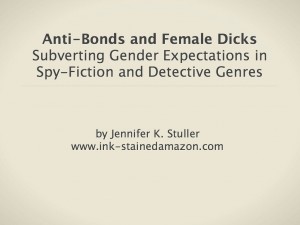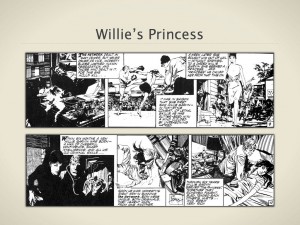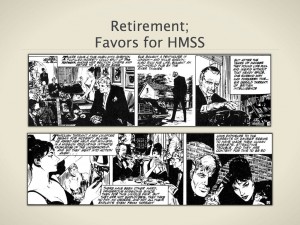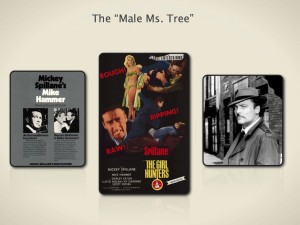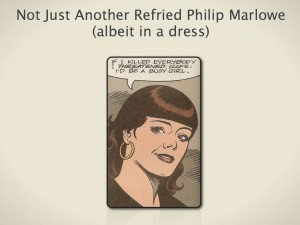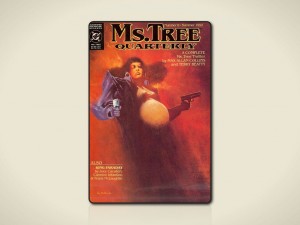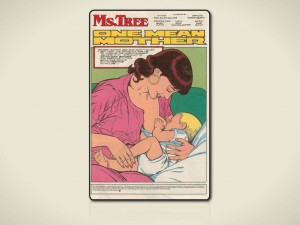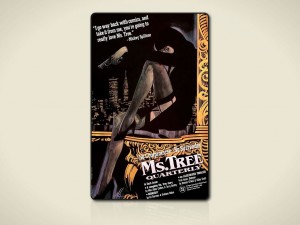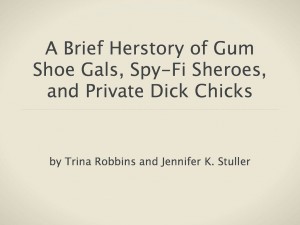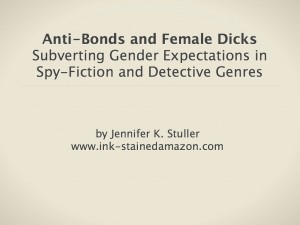More wonderful articles, posts, and podcasts featuring GeekGirlCon!
Portrait of an Adoption
“You Have To Hand it to the Geeks,” By Carrie Goldman
“Katie and I just returned from Seattle, where we attended the first-everGeekGirlCon. In case anyone doubts the need for a con devoted solely to the female population, consider the fact that the con was sold out and there were people lined up outside each room before panels began.”
Ape in a Cape
SOME PERSONAL HIGHLIGHTS FROM GEEK GIRL CON, Gail Simone
“Everything felt a little different. Lest you think this con didn’t have geek cred, let me assure you, the superhero/genre panels were absolutely as hardcore nerdy as any I have attended, but it was from a female and safe perspective. As a whole, the con felt more like a festival at times than a con…it was much less aggressive and without that odd hostility that some big cons have acquired. You would walk out of a panel, and there would be female musicians playing awesome acoustic sets. There were artists EVERYWHERE, women doing crafts and cosplay and drawings and paintings and mirror art and stained glass, and just on and on, everywhere you looked was something beautiful.”
Just Jenn
Geek Girl Con 2011, Just Jenn
“More than any other con I came away with a renewed desire to create, to become a better person. For the first time at a con – every single panel topic appealed to me and pertained to my interests. It was small enough to be able to walk and talk with my heroes and my peers and it really felt like the things that I did mattered.”
Critical Hits
I Was a Manchild at Geek Girl Con, by Logan Bonner
“After the concert, I checked out “Ink-Stained Amazons & Cinematic Warriors,” a panel about the book by Jennifer K. Stuller. She appeared multiple times in the Wonder Woman documentary, and I was interested in hearing more from her. Her presentation was great, with a slideshow and video to supplement her lecture/discussion. She broke down the traits typical of heroes, the ways female characters match or defy those expectations, what that says about how female characters are viewed, and the ways their roles have changed over time. This and the Wonder Woman panel were both great, and it seems like this book and that movie could serve as great companion pieces.”
Fangirl Blog
Geek Girl Con Sunday Roundup, by Tricia
“Cattiness has been a hot topic in geek girl circles recently, and the Killing Cattiness and Creating Community panel dove right into it. Just like the SDCC panel, Oh, You Sexy Geek!, this topic was addressed as part of the discussion, and two of the panelists from that discussion were on the dais again – Bonnie Burton and Jennifer Stuller. I think it’s important for geek girls to see all different types of women interacting in a positive manner, even if they don’t like the same things or they hold contrasting beliefs. I’ve witnessed it at two separate cons now, and it’s so uplifting and empowering to watch.”
Gender Focus
Geek Girl Con: Feminism, Race, and Geek Culture, by Jarrah Hodge
“[T]he panel addressed how geek communities, especially online, can exclude women and people of colour. The panelists said they felt like when they or others raised objections to sexist or racist language or behaviour guys would rally to defend the sexist and racist games, attempting to make the argument that somehow criticizing the language or behaviour was against their geek allegiance.”
Geek Wire
What geek guys missed at GeekGirlCon, by Mónica Guzmán
“It was liberating to be one of many women at session after session, if only because you knew you could say out loud some of the things women whisper to each other at other geek events.
That doesn’t mean you always did.
In some ways, the geek gender gap had to be part of the conversation, if only to assert the reasons why GGC exists in the first place. But talking about the gender gap alone won’t close it. And to organizers’ credit, their convention was in no mood to whine, ruminate or despair.”
Comics Bulletin
Geeking Out at Geek Girl Con, By Kyrax2
“At Geek Girl Con, women and men came together on an equal playing field. Geeks of all stripes were in attendance. I saw Trekkies and Twihards, Star Wars fans and Harry Potter enthusiasts, coders and gamers and mathletes and science geeks and otaku and yes, even comics geeks. Everyone was welcome. Everyone was treated with respect, regardless of age, gender, race, religion, sexual orientation, physical or mental ability, weight, height, or any other factor.”
A mí, mis comics
Geek Girl Con: primeras impresiones, Alejandra Espino
“It was my first convention of this kind, and I could not have chosen better.”
Lotus Girl Films
1ST ANNUAL GEEKGIRLCON!!!
“The prospect of attending a full-on geek fest devoted to all things SHE was exciting to ponder. The reality has gone so far beyond the expectations, that it all feels a tad surreal.”
Chicks With Crossbows
Geek Girl Con Panels: Steampunk!
“This panel was so popular, they actually had to switch rooms and put it in the larger space. The line wrapped all the way around the hallway.”
Stranger SLOG
Geek Girl Con, by MARY TRAVERSE
“And most importantly there were the nerds themselves: it filled my heart with joy to see women in their 60s as well as teen and tween girls all gleefully letting their geek flag fly. It made me wish I’d had a con like this when I was all awkward and 14 and hiding my obsession with dinosaurs. (Note to teen me: it gets better!)”
Paper Napkins on the Edge of Insanity
Geek Girl Con: Reflections
“I still can’t believe how my girls opened up at Geek Girl Con. I can’t believe how welcome I felt, and I usually am uncomfortable in high female ratio environments. I was so nervous, yet excited before it started, and now I hope next year will bring the same feeling, but more than that. I hope the self confidence that was some how given, inspired, drawn-out of my precious little geeks stays a gift from Geek Girl Con for their lives, making them strong women of the future (whether they stay on the paths of the geeks or not!)”
GeekGirlCon Reflections (a guys perspective.)
“GeekGirlCon benefited from being focused on GeekGirls, but also on the broader geek culture as a whole. It worked very well and there was an amazing amount of content. In addition to the geeky topics I mentioned above, there were panels on ethics, sexism, and gender issues to be sure, but also a refreshing look at academic, science, and STEM careers, geek parenting, working as a coder, game design, and geek crafting (cosplay, craft, and mask making among others). There were often four panels running at once along with signings and craft and game workshops. One person could only see maybe 25% of the Con even if they ran full steam all day long.”
The Inferno
“Reblogging to get the word out. Geek girls are not a small target audience. How long can the media and society ignore that? If GeekGirlCon is any indication, not much longer.”
Optimystical Studios
GeekGirlCon Round-Up
“First let me give some major props and thank you’s to the astounding crew of GeekGirlCon. These ladies worked their collective butts off to make sure everyone had a good weekend. And it showed. Zaph & I spent some time discussing the con on the drive home, and we both agree that everyone on the crew both knew what their job was and knew to ask (instead of making up an answer) if something wasn’t part of their specialty.”
Look! It’s Julia
GeekGirlCon Links!
“I’ve been reading some of the wonderful things that people are writing about GeekGirlCon online, so I’d thought I’d share some links.”
Defective Geeks
Geek Girl Con 2011: Not Just for Girls: by Space Pirate Queen
“Most of all, a shout out to the women who put the entire convention together. The convention sold out! The entire thing ran smoothly. More so than a lot of conventions that has been around for many years. These girls worked their butts off and I am proud of all of them for following their visions and sticking to what they believed in. They’ve created a platform where we can discuss important topics without fear of getting attacked or misunderstood. I believe that it will change our community for the better.”
THE TERESA JUSINO EXPERIENCE
GeekGirlCon: The Squee-port
“The staff was extremely helpful, the design of the show was great, and all of the programming was actually substantive. There wasn’t a “fluff” panel on the entire schedule. Each one either taught you how to do something, or brought together panelists who were truly knowledgeable and articulate about the topic being addressed. “
. . . and . . .
“[T]he fact that I was sitting on a panel with these ridiculously talented women, and afterwards was treated as if I deserved to be there? Well, that made me feel rather good.”
Ramblings of a Prodigal Goddess
GeekGirlCon review, etc.
“I am writing this review from the point of view as a staff member. I didn’t get to see everything I wanted to see and therefore cannot give an opinion. The review also serves as a reflection on my feelings and thoughts toward the experience that forced me to come out of my shell.”
Possible Impossibilities
It’s the Geek Girls’ World
“GeekGirl Con‘s time had come. Women have had panels thrown to them here and there — with, for the most part, the same topics, the same panelists, and, alas, the same problematic moments — at behemoth geek convergences like Comic-Con International for years. Could they have a convention of their own? Would it be a success?
After the past weekend’s GeekGirl Con, we now know: Yes and yes!”
GeekGirlCon
THANK YOU!
“The first-ever GeekGirlCon was a huge success! The con sold out on both Saturday and Sunday. We saw approximately 2,000 people come through the doors over two days to celebrate the contribution of women in geek culture. Attendees, panelists, guests, volunteers, vendors, artists, exhibitors, sponsors, media, parents, kids, and staff came together to create a safe place for everyone and anyone identifying themselves as geeks this past weekend. We should all be very proud of making this ambitious idea a reality.”
Sliver of Ice
GeekGirlCon 2011: Some Presidential Thoughts and Other Things
“I am pretty much beyond biased about how awesome GeekGirlCon was. Along with my staff, I’d worked since August 2010 to make the dream of GeekGirlCon a reality, and I believe that it truly happened. I fought back happy tears all weekend; only to finally cry Sunday evening after reading what Greg Rucka wrote in my Batwoman trade. (Don’t worry, at that point, I was surrounded by people who care and love me and hugged me.)”
KING 5
‘Geek Girls’ gather at Seattle Center
“GeekGirlCon is drawing hundreds of women and girls to an event centered on gaming, fantasy, technology and science fiction. KING 5 Photojournalist Ron Sanford has the story.”
Chicks with Crossbows
Geek Girl Con Panels: Batgirls! (Or, Women in Comics)
“If you haven’t heard of Kyrax2, aka San Diego’s Batgirl, here’s the deal: She’s a fan of comics. This year at San Diego Comic Con, Kyrax2 went to many of the DC panels and asked questions about the lack of women both in the comics and on the panels themselves. This got various responses although she was booed at least once. Thus, at Geek Girl Con, she hosted a panel, along with DC Comics Writer Gail Simone, to address these issues and discuss the state of women in comics.”
CNN: Geek Out Blog
‘Dammit Liz’ went to Geek Girl Con (and it was worth it)
“It was a panel-centric convention, with panelists like Jane Espenson, Gail Simone, Javier Grillo-Marxuach, Amy Berg and Bonnie Burton emphasizing strong, capable female characters in science fiction, comics, games and pop culture. Over-sexed, stripper-clad female characters were barely mentioned, Smith said.”
Sarah Darkmagic
Geek Girl Con Recap
“Why go? . . .To hear a diversity of viewpoints . . . To see women presented as experts and leaders . . . To learn about some pretty awesome books, movies, and projects I have to admit, I hadn’t heard of Ink-Stained Amazon before the con. I went to the panel by Jennifer Kate Stuller and it was really good and I can’t wait to buy her book, Ink-Stained Amazons and Cinematic Warriors: Superwomen in Modern Mythology. Womanthology also presented at the con. . . . Building networks . . .”
Fleeing Indecision
Safety; or a lesson in geekery from GeekGirlCon.
“Well, how was it? In a word: unbelievable. The atmosphere was warm, welcoming and safe. Every single volunteer had a smile on their face the entire weekend. The panels were informative, varied and fun. The cosplay was some of the best I’ve ever seen. But I’ll repeat myself here and say that the most important thing about GeekGirlCon was its safe and welcoming environment.”
Back That Elf Up
GeekGirlCon 2011 Report
“Basically, I got to see something awesome and be a part of something where I FELT like I belonged. In a lot of settings I can feel left out because there is usually something about me that does not quite fit. Sometimes it’s my gender, sometimes it’s my introversion, sometimes it’s my pastimes and interests and sometimes it’s my race. But I didn’t feel like that GeekGirlCon. Even though I was hawking books I still felt…at home. Which is kind of strange because the types of geeks that were there spanned the universe (almost literally, heh).”
Closet Nerd Network
Geek Ladies in the House: Reflections on GeekGirlCon 2011
“At GeekGirlCon, like many others, I felt like FINALLY here are my people: accepting, joyous, smart and vibrant geeks who are going to be the future of nerdom. We care about issues, we want to make things better, we question what media we’re fed and we want to show the world how awesome being a nerd is instead of closeting our community away! GeekGirlCon has become the exception to the rule of geeks who turn the tables on what they consider to not be “true fans” and have created a safe place where we can get down to brass tacks about how to change fandom.”
Good Game Media
GGM Visits Geek Girl Con 2011
“Last weekend the Good Game crew piled into the GGM Mobile and drove down to Seattle Washington to check out the first ever Geek Girl Con. While we were down there I had a chance to talk to some of the female con goers and ask what they thought of a con just for them.”
Sailor St. Claire
GeekGirlCon 2011
” Lots of great conversation arose about a variety of topics relating to female fandom: objectification of “booth babes,” women in webseries, women in tech, race and technology, and other practical and craft-based panels on steampunk costuming, cosplay, and gaming. “
Stern-Rake Studio
GeekGirlCon at Night
“As the autumn sun set and the younglings were sent off to their suppers, the gears of GeekGirlCon shifted to more adult-themed topics.”
The Girl in Row B
GeekGirlCon:Life on the other side of the registration table
“Thank you to all of our panelists, vendors, special guests and attendees. And a special thank you to all of the people who gave money, time, and/or support to make this convention happen. It was a success and without all of you it would never have happened.”
Archive Six
HOW GEEKGIRLCON CHANGED MY LIFE: A REFLECTION & REVIEW
“In the past, I had wasted so much time and energy trying to conform to society’s expectations that I lost sight of who I really am. GeekGirlCon not only gave me an opportunity to design for a cause I could stand behind, but also welcomed me into a safe community where I could finally let my geek flag fly without having to prove or justify my geekiness, or be judged for my gender identity, ethnicity, sexual orientation, size, or Doctor preference (4th and 11th, for the record). It amazes me how much personal growth I have achieved in this past year alone. It is through GeekGirlCon that I was able to meet and form meaningful and long-lasting relationships with people who I greatly respect and admire, and who inspire me more and more with each passing day. These people have helped me find my voice in this world, and gain the courage to finally speak up for myself and my beliefs.”
Chicks With Crossbows
Geek Girl Con: General Con Report
“The Con Was Organized by Meticulous OCD Ninjas [and] The Panels ROCKED.”
Gender Focus
Geek Girl Con: Media Literacy, Criticism, and Production
“I was particularly excited about this panel because it featured the awesome Anita Sarkeesian of Feminist Frequency as well as Kelsey Wallace and Kjerstin Johnson, who were my editors when I was writing the Revenge of the Feminerd series for Bitch Magazine blogs. The other panelists were Kristy Guevara-Flanagan, director of The History of the World as Told by Wonder Woman as well as Wilson, editor of Smart Pop Books. The panel was moderated by Maile Martinez, programming director at Reel Grrls.”
PopMatters
Comics Needs Women: Why Marvel and DC Should Have Been at Geek Girl Con
“[T]he publishers need girls and women more than girls and women need Marvel and DC.”
Girl Hack
Geek Girl Con 2011 Review
“I am still new to the geek- convention circuit, but Geek Girl Con delivered the most fulfilling con experience I’ve had, as both a geek and a woman.”
Defective Geeks
Geek Girl Con 2011: Feminism, Race & Geek Culture Panel
“I am glad I went to this panel. I wasn’t sure what to expect but I was rewarded with a great discussion with well-spoken women. They touched on quite a few interesting points about female and Asian culture in geek media. What I really appreciated about the way these women approached sensitive issues without having to be defensive or threatening to other people. They even gave great advice on how to deal with negative internet interactions.”
Journal of J
Geek Girl Con Reactions
“Overall this con was a great jolt of inspiration for me, not only as a girl gamer but as someone who hopes to make games. The camaraderie and heartfelt support was palpable, and the issues discussed were thought provoking and important. It was a great start to an awesome new tradition, and I don’t have any doubt that it will be continuing next year.”
Lady Sabre & The Pirates of the Ineffable Aether
NYCC and Geek Girl
“GGC felt practically like a family gathering, and I suppose, in a way, it was just that. The fact is, women remain under-represented and poorly served in so many realms of geek culture; having a convention that speaks to that lack, that attempts to address it, is more than a worthy goal; it may well be a holy one.”
Comics Bulletin: The Squeaky Wheel
Geeking Out at Geek Girl Con: Part Two
“I *got* it. We women subsume our own tastes for fear of being thought ‘too feminine’. We are limited by what people think will appeal to us. We are seen as an amalgamation, as though what appeals to one woman will appeal to all. We push our children to be like us, to like the things we like, never realizing that we are repeating the same mistakes our parents made. We’re told that we have to ‘vote with our dollars’, but when we do choose not to buy something, the action is often ignored or misinterpreted.
And yet, we do have power. We have the power to speak, the power to buy, the power to teach and share and give. We don’t need to listen to those who say that we don’t have any power, that it isn’t ours, that it doesn’t ‘belong’ to use, that we shouldn’t speak, that we should ‘sit down and shut up’. Because they have no power over us…but what we give them.
And that’s what I learned at Geek Girl Con.”
GeekMom
The GeekMoms Podcast #6 GeekGirlCon, Women of Wonder Day
“Women of Wonder Day, an annual auction and in-store event where you can bid on beautiful art and collectibles in support of domestic violence charity programs. Later I’m joined by fellow GeekMom Cathe Post to talk about her weekend with her husband and daughter at the first ever GeekGirlCon in Seattle, Washington. This new entry on the convention scene drew some big Geek Girl names to help promote a positive attitude toward all geeks, men, women and especially kids. And you’ll also hear how the GeekMoms took a stab at the Google+ Hangout feature and ended up having a chat with Felicia Day.”
Defective Geeks
Geek Girl Con 2011: Arts & Crafts with the GeekGirlCon Design Team
“[T]his was a cute arts and crafts panel hosted by Tammy Vince Cruz and Rachelle Abellar from the Geek Girl Con’s design team. Not only were these two ladies busy churning out all the design collateral for the convention; they also organized a successful, interactive panel that encouraged attendees to drop by and make sock puppets.”
Nerd Appropriate
Geek Girl Con: No I Am Not a Booth Babe : Panel Coverage
“[U]ltimately the message that was delivered by the panelists was that we, as fans, need to play nice and work together towards better representation of women in video games. The trolling on message boards, the flame wars are all counterproductive and detract from the end goal: working to see women presented in games in a positive light. Behind the user names, Twitter handles, there are people. It’s one thing to be critical, to express dissatisfaction over a feature/presentation of a character/level, but making a personal attack does more harm than good and inhibits bringing about the desired change.”
The Intersection of Dykedom and Dorkdom
Geek Girl Con 2011 Report
“The programming had something for everyone – a variety of topics, genres and media, both academic and non-academic discussion, films, science [and] was accessible for younger and older audiences”
…and…
“The Ink Stained Amazons and Cinematic Warriors: Superwomen in Modern Mythology panel: Jennifer Stuller gave a presentation that hit the highlights of her book, discussing female heroes in modern popular culture from the 40’s to the 21st century and their impact during their time and on future heroes. One of the trends she noted was the lack of women training women: in most cases the women are mentored by their father or a father-figure. That’s a trend I hadn’t noticed before, but see frequently now that I’m aware of it –definitely food for thought. Booboo enjoyed the panel enough to buy the book immediately after the panel ended.”
Jewish Book Council Blog
Their (Our) Time Has Come
“GeekGirlCon is for the Rest of Us; maybe not 99%, but definitely 52%, the women who have for so long been shut out of a male-dominated comics industry, and all the related male-dominated industries, like computers and gaming. It’s for us geeky girls who spent our high school years as outsiders, never cheerleaders, never dating the football team (often never dating at all!), but with our noses buried in science fiction or fantasy books or comics. All those geeky girls have grown up into enthusiastic and talented young women who are making great clothes and jewelry, creating wonderful new comics — and with not a superhero in the bunch. The energy level in the rooms was high and optimistic.”
The Official Website of Nancy Holder
Geek Girls are Here to Stay
“One of the best cons so far this year was GeekGirlCon. Girls and boys enjoyed panels on webseries, Science, Math, Technology, Engineering, vampires, and of course, all things Joss Whedon! I am very happy to say that Geek Girls are thriving! And DEFINITELY here to stay!”
Defective Geeks
Geek Girl Con 2011: Women Running Geeky Businesses
“I admire anyone who are smart enough to be able to turn their own passion and interests into a self-sustaining career… but it’s just that much more cool to have these geek girls talk about their own success. It was also a unique panel where the audience heard different success stories from women of all ages and very different career and life choices.”


